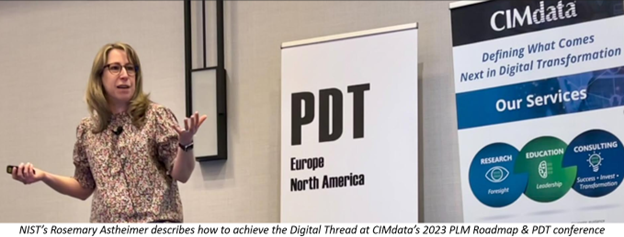
In May 2023, CIMdata sponsored the 2023 PLM Roadmap & PDT conference, which focused on advancing an understanding of the Digital Thread – moving product information to various systems across the manufacturing enterprise – an ongoing quest in industry. The conference included presentations on use cases and their implementations.
NIST’s Rosemary Astheimer provided a different perspective – how to achieve the Digital Thread. Astheimer began by describing how three-dimensional digital models of parts could contribute to the Digital Thread. Specifically, Astheimer focused on how a Computer-Assisted Design (CAD) could use a methodology called “Model-Based Definition” to capture engineering design data and criteria about a part and create a 3D representation of it. The CAD data could then transfer this 3D digital data to systems which can be used to automate manufacturing and inspection of the part and many other activities.
Such a 3D digital model, read by systems, represents a significant advance over 2D drawings of parts, which require human interpretations. This use of 3D digital models eliminates risk of errors associated with human interpretations of 2D drawings, providing an unambiguous definition that speeds manufacturing and makes it more competitive.
Astheimer also pointed out that the Digital Thread depends on setting standards which will enable systems to exchange and read digital data. Astheimer addressed ongoing initiatives to standardize industrial data exchange; these include efforts by ISO’s Technical Committee 184/SC4, and groups such as the MBx Implementor Forum, which accelerates translator development through definition standards.
Lastly, Astheimer stated that Product Lifecycle Management (PLM) processes and Product Data Management (PDM) software are key to managing data and enabling the exchange of information in a repeatable, efficient, and secure way. And equally important, robust data are required to reap the benefits of the Digital Thread.

